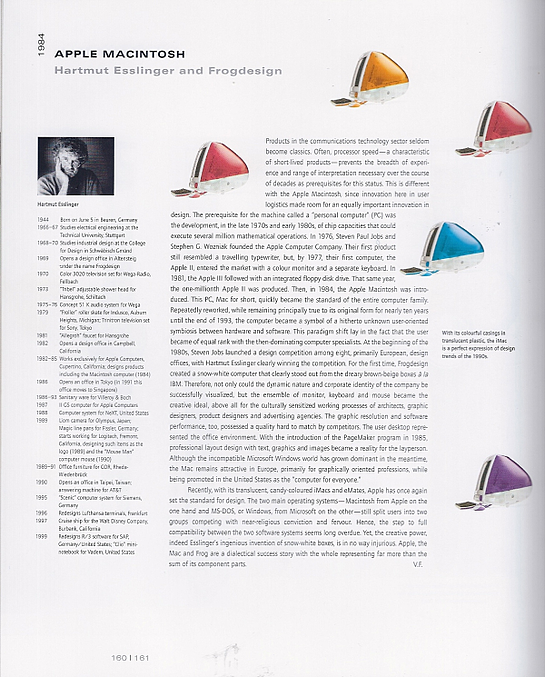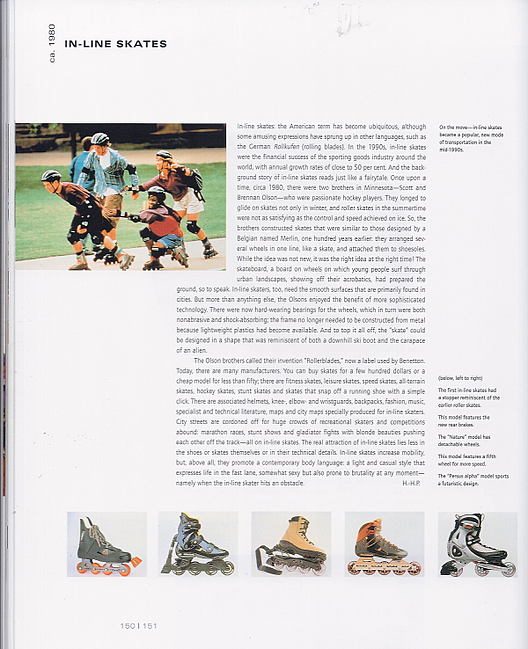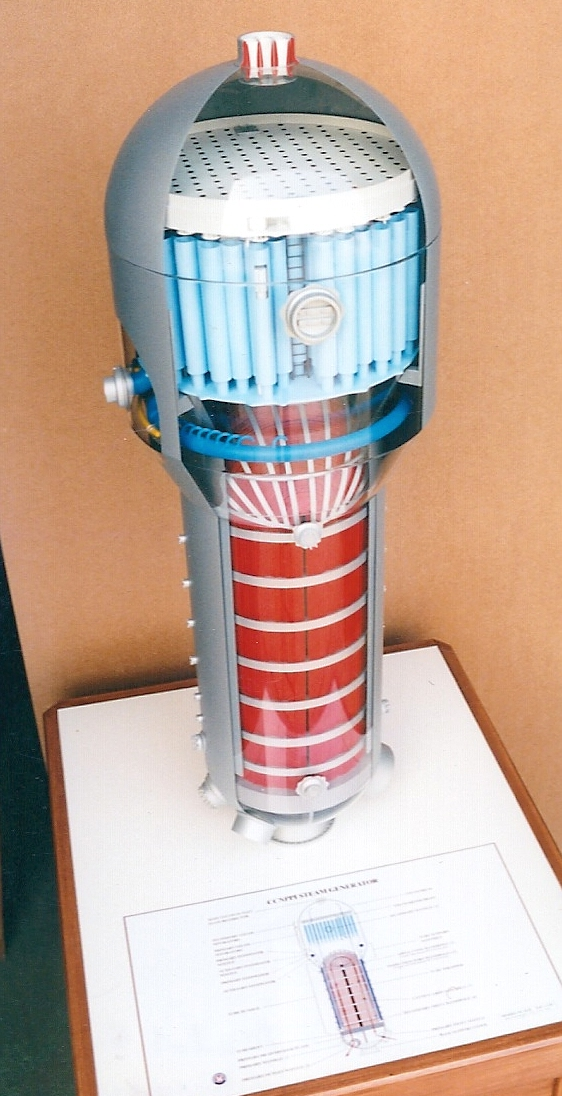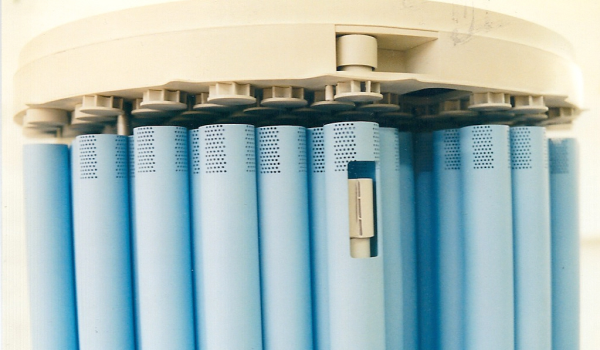"Objects of Design from the Museum of Modern Art" by Paola Antonelli is the fourth book review of great product designs. Industrial designers created many of the objects here. This book was published in 2003 with color photographs by The Museum of Modern Art, New York. It is quite different from the MOMA's 1970 book "The Design Collection - Selected Objects" which showed objects in black and white with a label but little text. Their design collection was established in 1934 and at the time of this latest book's publication had over 3,708 mass produced or homemade objects (although most in the collection are mass produced).
The MOMA design collection now is "a critical and exclusive assembly rather than encyclopedic and comprehensive. One of the leading characteristic's of the Museum's design collection is the idea that its design objects are part of larger visions within which they are best seen." The center of gravity of the MOMA design collection has begun to shift from the machine age to the digital age. Their challenge is to find what "objects most clearly tell us about ourselves, the culture that produced them, and the world in which we aspire to live."

Unlike the last three books reviewed "Objects of Design" has far more pictures of objects - 341 total and all in color. The objects are grouped into nine thematic sections and each section has a separate author.
1. Turning Points. Basically this covers the change to the point of view that art should be available to all in mass produced objects, organic and simple geometric forms without ornamentation and aesthetic abstraction. Otto Wagner, Gustav Stickley and Frank Lloyd Wright designed chairs, tables, silverware, etc. in the beginning period of modernism.
2. Machine Art. The Museum's 1934 exhibit "Machine Art" focused on the unintential beauty of these highly functional machine parts. The Bell 47-D1 Helicopter 1945 is one example.
3. A Modern Ideal. Works of art and and objects of design from Bauhaus studios and workshops from the 1920's on fit this theme. Eileen Gray's Adjustable Table 1927 and Tube Lamp 1940's, Le Corbusier's Chaise Longue and his Armchair1928, Marcel Breuer's Tea cart Model B54 1928 and Mies van der Rohe's Barcelona Chair 1929 and Tugendhat coffee Table are some of the examples.

Marianne Brandt Table Clock 1930
4. Useful Objects. In 1938 the Museum worked with retailers to exhibit good designs that were affordable to the average consumer. The exhibit was called "Useful Household Objects under $5.00." This exhibit was shown in 7 cities in addition to New York City. Objects were chosen by their suitability of purpose, material and process of manufacture". The Useful Object exhibit was so successful that they repeated the tour for nine more years with new useful objects each year although the price gradually increased to $100.00 in 1947. In the objects "form and beauty follows function". Innovative functionality and integration of new materials like heat resistant Pyrex glass led to the glass frying pan and baking dish. Plastics revolutionized consumer products by the 1950's. Good useful design wasn't expensive and was available to everyone. Examples are the Electric Hairdryer 1928, Corning Glass Works Baking Dish 1949, LEGO Building Bricks 1954-1958, the Bic Cristal pen 1950 and Post-it Note 1977.

Earl S. Tupper Pitcher and Creamer 1946
5. Modern Nature. Organic might be a way to describe this influence on designed objects. In part technology enabled a new relationship with materials and processes in creating objects. Thonet, Eames, Aalto, etc. explored new materials that led to new possiblities with designed objects, especially with curvy organic shapes

Alvar Aalto Vase (no. 3031) 1936 and Paimio Chair 1931-32
6. Mind over Matter. Many new materials, mostly synthetics, were created during WWII and designers explored their possibilities which led to "new functions and applications and astonishlingly innovative forms." Plexiglas (introduced in 1936), polycarbonate and other plastics enabled designs that could be shaped and hardened to create continuous surfaces and curved surfaces without joints. Developments in plywood technology meant it could be formed into compound curves. Later carbon fiber permitted even "thinner and lighter continuous-form objects without joints."
In 1995 the museum exhibition "Mutant Materials in Contemporary Design" explored this mind over matter relationship. A particular material could be shaped and used differently in products by the designer. Vernor Panton's Stacking Side Chair 1959-60 was the first chair cast in one piece and from a synthetic material (polyurethane plastic). No assembly or hand labor was required.
7. Good Design. This theme covers the MOMA's series of Good Design exhibitions between 1950 and 1955. The idea was to influence wholesalers and manufacturers of consumer goods into thinking that there was probably a large market for well designed products. Objects featured here include Alvar Aalto's Tea Trolley 1936-37, Charles and Ray Ames Low Side Chair model LCM 1945, Eerp Saarinen's Tulip Armchair and Richard Sapper's Tixio Table Lamp 1971.
8. Good Design for Industry. As noted here many great industrial designs resulted from a close collaboration between the industrial designer and the manufacturer. MOMA exhibits that explored this topic first started in 1952 with "Olivetti: Design in Industry". Objects pictured in this thematic topic include Electric Kettle 1909, Minox Riga Camera 1936, Chemex Coffee Maker 1941, Kodak Carousel-S Slide Projector 1963, Dieter Rams Loudspeaker model LEi 1960, Swatch Jellyfish Watch 1983., Macintosh SE Home computer 1984, Apple G4-Cube Speakers 2000 and the Smart Car 1998.
9. The Object Transformed. The MOMA's 1966 exhibit "The Object Transformed" was mostly art works inspired by design objects like the Display stand for Oranges, the Malitte Lounge Chair, 1966, the 85 Lamps Lighting Fixture 1992 and the Honey Pop Armchair. They transform materials into functional objects in creative ways.
"Objects of Design" is a large book at 286 pages but it is an interesting interweaving of 9 themes that cover a century of products with plenty of color pictures and enough interesting text on well designed products to provide a comprehensive perspective on industrial designers and their products during the 20th Century.
Do you have a favorite book on industrial design prototypes, products or designers? Please let us know by posting a comment. If you have any questions or would like to discuss prototypes or other projects contact us at Model Builders, Inc. 773-586-6500 or info@modelbuilders.net .



















1.jpg?width=309&height=187&name=dsc03157_crop_(1)1.jpg)



-resized-600.jpg)















